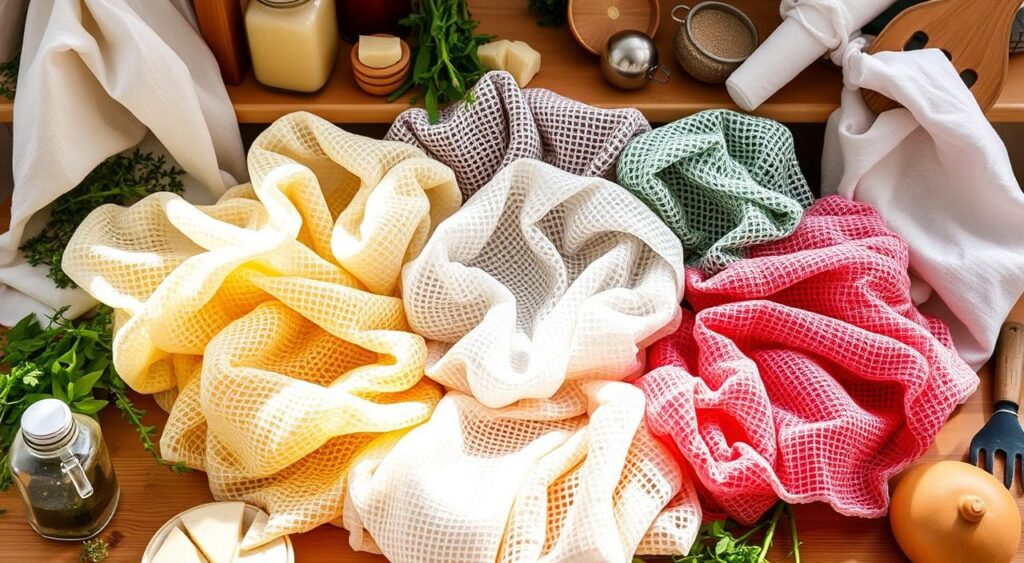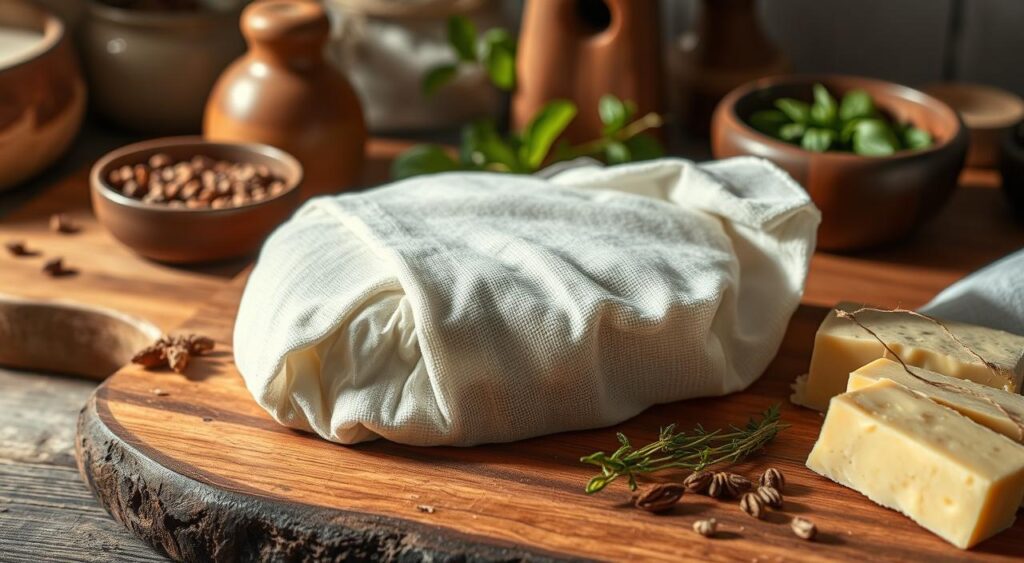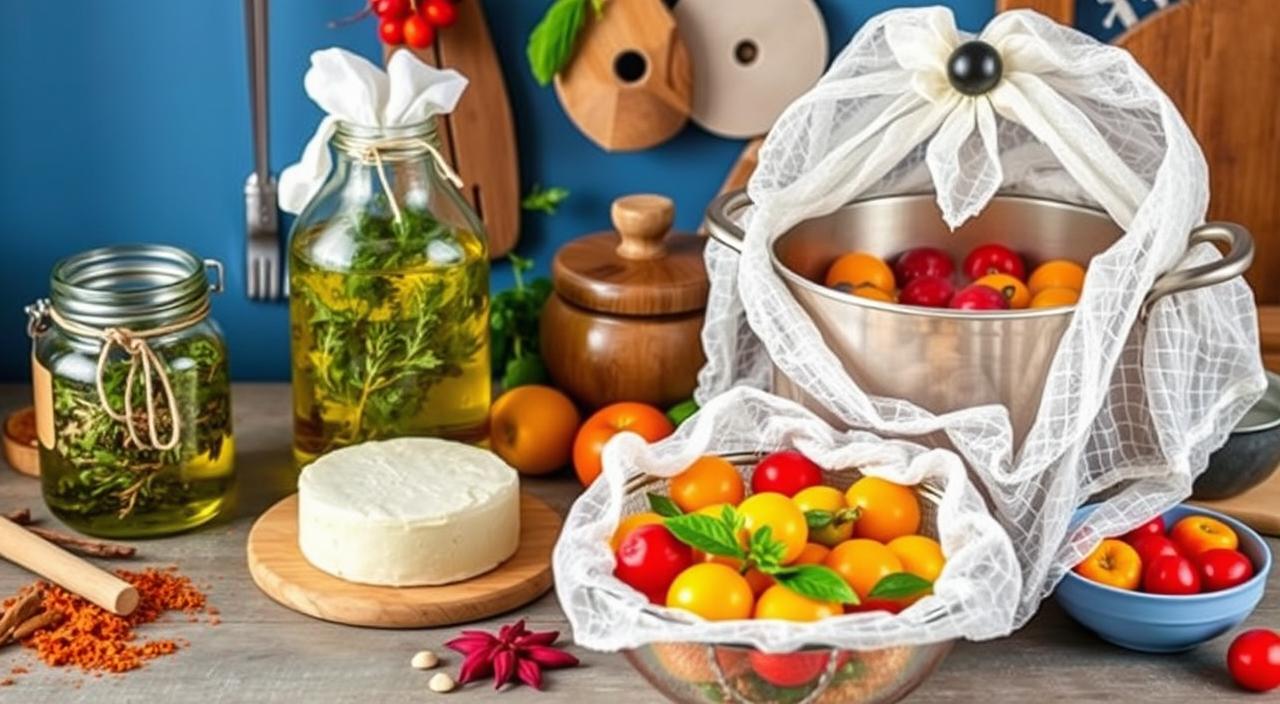I love exploring the many uses of kitchen tools. Cheesecloth is one of my favorites. It’s not just for making cheese. It can change how you cook and clean. Get ready to see how cheesecloth can make your kitchen better.
Cheesecloth might look like a simple piece of fabric. But it’s actually very useful in the kitchen. You can use it to strain liquids, baste meat, or even clean silver. Its malleable and breathable qualities make it perfect for many tasks.
We’ll show you many ways to use cheesecloth in your kitchen. It’s great for making cheese, pastry, and more. This straining material is a game-changer for cooks.
Understanding Cheesecloth: A Kitchen Essential

Cheesecloth is a must-have in every kitchen. It’s lightweight and lets air through. Made from food grade textile, it comes in different grades. Each grade has a special weave and thread count for various cooking tasks.
Different Grades of Cheesecloth
Cheesecloth comes in many grades, from coarse to fine. The Grade #10 has 20 x 12 threads per square inch. The Grade #90 has 44 x 36 threads per square inch. Knowing these grades helps you pick the right one for your needs, like straining broths or mixing ingredients.
Why Every Kitchen Needs Cheesecloth
Cheesecloth is more than just for cheesemaking. It’s great for straining, making herb sachets, and even decorating. Its breathable and reusable qualities make it eco-friendly for kitchens.
Properties and Characteristics
Cheesecloth is 100% cotton and perfect for food. It’s soft, absorbs well, and easy to clean. You can wash, boil, or machine-wash it. Its different grades offer various breathability and filtration levels, making it a key tool for kitchens.
Traditional Cheese Making with Cheesecloth

Cheesecloth is key in making homemade cheese. It helps strain the curds from the whey. This is important for the cheese’s shape and texture. Making homemade ricotta cheese is a great example.
To make ricotta, you need 4 cups of whole milk, a pinch of salt, and a few tablespoons of lemon juice or vinegar. Heat the mixture gently, stirring now and then, until the curds form. Then, pour it through a cheesecloth-lined strainer. This captures the soft, creamy ricotta curds in the cloth.
The straining curds through cheesecloth is crucial. It removes excess whey, giving the homemade cheese its right texture. The ricotta is great for lasagna, ravioli, creamy dips, and desserts.
Cheesecloth is not just for ricotta. It’s also used for other soft homemade cheesees. It helps shape and drain the curds. This traditional method makes delicious cheese and connects us to cheese’s rich history.
Straining Broths and Stocks
Creating flavorful broths and stocks is easier with cheesecloth. This straining material removes impurities, making your liquids clear. It’s perfect for clarifying bone broth or making a delicate consommé.
Clarifying Homemade Stocks
For making chicken or beef stock, cheesecloth is key. It strains out tiny particles and fat. Just line a colander with it and pour the cooled stock through.
This ensures your stock is smooth and ready for soups and stews.
Creating Crystal Clear Consommés
For a clear consommé, cheesecloth is crucial. Wrap it around a spoon or ladle to skim the surface. This removes foam and impurities, keeping your broth clear.
“Cheesecloth is an invaluable tool for straining broths and stocks, ensuring a pure, flavorful final product.”
Removing Impurities and Sediments
Whether it’s a hearty bone broth or a delicate consommé, cheesecloth is essential. It catches even the smallest particles, leaving you with a clear, restaurant-quality broth.
Basting and Cooking Poultry
Cheesecloth is a must-have in the kitchen for cooking poultry. It helps keep chicken or turkey moist and full of flavor. Just wrap the meat in cheesecloth soaked in white wine, olive oil, and melted butter.
The cheesecloth lets heat spread evenly and cooks the meat slowly. This keeps the cotton fabric from drying out the meat. As the poultry cooks, the cheesecloth bastes it with the tasty liquid. This makes the bird juicy and golden, perfect for any meal.
“The breathable cheesecloth allows the culinary tool to cook evenly while locking in moisture for the most tender, flavorful poultry.”
Cheesecloth is a game-changer for roasting turkey or searing chicken. It’s a key part of any kitchen. Its ability to enhance cooking makes it a must-have.
Creating Herb and Spice Sachets
Cheesecloth is a great culinary tool for making flavorful herb and spice sachets. These food grade textile sachets help you add the right amount of herbs and spices to your food. They’re perfect for making a French bouquet garni or your own spice mixes.
Bouquet Garni Techniques
The bouquet garni is a mix of parsley, bay leaves, and thyme wrapped in cheesecloth. It’s simmered in soups, stews, and sauces. This method has been used for centuries to add a nice mix of herb flavors to dishes.
Spice Combinations for Different Dishes
You can also make spice sachets for specific dishes. For example, a chai tea blend includes fennel seeds, cardamom pods, cinnamon, star anise, and peppercorns. For a beef stew, try a mix of cloves, allspice, and bay leaves. Cheesecloth makes it easy to experiment with different spice combinations.
Reusable Sachet Tips
Make several batches of herb and spice sachets to have them ready for quick flavor additions. These food grade textile sachets can be used over and over. With a bit of creativity and the right culinary tool, you can make dishes that taste like they’re from a restaurant.
Innovative Pastry and Baking Applications
Cheesecloth is not just for cheese-making. It has many uses in pastry and baking. Its versatility and breathability make it a great tool for food preparation and presentation.
Use cheesecloth as a duster for desserts. Fold it into a pouch and fill it with powdered sugar, cocoa, or cinnamon. This method gives your cakes and tarts a professional dusting. The cheesecloth’s fine weave spreads the powdered ingredients evenly.
Cheesecloth is also great for baking. It prevents pastries from sticking to baking sheets or pans. Its absorbent nature helps keep baked goods crisp and flaky.
“Cheesecloth is a game-changer in the pastry kitchen. Its versatility knows no bounds – from dusting desserts to lining baking pans, it’s an essential tool for the modern baker.”
Whether making homemade croissants or a stunning layer cake, cheesecloth can help you get professional results. Use this kitchen tool to boost your creativity in pastry and baking.
Making Homemade Plant-Based Milks
Cheesecloth is a must-have for making homemade plant-based milks. It helps separate the creamy liquid from the pulp. This straining material is crucial for making almond, cashew, or hazelnut milk smooth and velvety.
Nut Milk Preparation Guide
Soaking nuts like almonds, cashews, or hazelnuts overnight is the first step. Then, blend them with water. Strain the mix through cheesecloth for a delicious homemade milk. This method is cheaper than buying milk with only 2% of the nut.
Straining Techniques for Smooth Results
Getting a smooth texture is all about proper straining. Squeeze the cheesecloth gently to get every drop of milk. The leftover pulp is great for adding to granola, smoothies, or as a yogurt topping.
Storage and Preservation Tips
Homemade plant-based milks last about 4 days in the fridge. Keep them in clean, airtight glass containers to stay fresh longer. For longer storage, consider the Almond Cow. It makes 5 cups of milk from just 1 cup of almonds, saving money and time.
Food Preservation and Storage Solutions
Cheesecloth is more than just for straining in the kitchen. It’s great for keeping food fresh at outdoor events. Its breathable nature lets air in while keeping bugs out. It’s also perfect for wrapping cheese, letting it breathe and stay dry.
Cheesecloth is a game-changer for homemade jams and jellies. Its breathable cloth helps separate solids from liquids. This makes your homemade preserves clear and delicious. It’s a must-have for home cooks and professionals alike.
“Cheesecloth is a versatile tool that can transform your food preservation and storage game, from protecting delicate cheeses to straining homemade preserves with ease.”
Cheesecloth comes in different grades and thread counts. This makes it versatile for many tasks. By using it, you can find creative ways to keep your food fresh.
Kitchen Cleaning and Polishing Uses
Cheesecloth is not just for cooking. It’s also great for cleaning and polishing in the kitchen. Its slightly rough texture is perfect for removing water stains and residue from silverware, pots, and pans. Just dampen the cloth and add some baking soda for a natural, streak-free shine.
Cheesecloth also works well for cleaning windows, glass, and other smooth surfaces in your kitchen. Its unique weave traps dust and grime without leaving streaks or lint. This makes it a top choice for keeping your kitchen looking sparkling and polished.
“Cheesecloth is a kitchen essential that goes beyond just cooking – it’s a versatile cleaning and polishing powerhouse.”
Need to freshen up your stainless steel appliances or glass cabinets? Keep a roll of high-quality cheesecloth handy. Its cotton fabric and various grades make it a must-have kitchen utensil for all your cleaning and polishing tasks.
Specialty Culinary Applications
Cheesecloth is more than just for cheese. It’s a culinary tool that makes food prep easier. It’s light and great for straining, helping you try new recipes and techniques.
Creating Labneh and Strained Yogurt
Making labneh, a Middle Eastern yogurt spread, is simple with cheesecloth. Mix full-fat yogurt with salt, then strain it for two days. This makes a thick, tangy yogurt that’s perfect as a spread or dip.
Cold Brew Coffee Preparation
Cheesecloth is key for smooth cold brew coffee. It strains out coffee grounds, leaving a clean, strong concentrate. You can mix it with water or milk to your liking.
Juice and Tea Straining
Cheesecloth is great for juices and teas too. It filters out sediment, making your drinks smooth and clear. Whether it’s fruit juice or herbal tea, cheesecloth makes it better.
“Cheesecloth is a kitchen essential that goes far beyond its traditional role in cheese-making. This versatile straining material can elevate your culinary creations in countless ways, from creating specialty spreads to brewing the perfect cup of coffee.”
Conclusion
Cheesecloth is a must-have in today’s kitchens. It’s used for everything from making cheese to new cooking tricks. It’s a key tool for both chefs and home cooks, making cooking easier and more fun.
Cheesecloth is great for straining, filtering, and preparing food. It’s also used in medicine and for cleaning. There are many types of cheesecloth, so you can find the right one for you.
Start using cheesecloth to make your cooking better. It helps you get professional results and makes your dishes taste amazing. With cheesecloth, you can do more in your kitchen and make your cooking even better.
FAQ
What is cheesecloth?
Cheesecloth is a lightweight, cotton fabric used in the kitchen. It’s great for many tasks, not just making cheese.
What are the different grades of cheesecloth?
Cheesecloth comes in different grades. You can pick the right one for your cooking needs.
Why is cheesecloth an essential kitchen tool?
Cheesecloth is very useful in the kitchen. It’s good for straining, basting, and even cleaning. It’s a must-have for many tasks.
What are the properties and characteristics of cheesecloth?
Cheesecloth is breathable, reusable, and eco-friendly. It’s great for straining and filtering in the kitchen.
How is cheesecloth used in traditional cheese making?
Cheesecloth is key for straining curds from whey. It helps drain and shape the cheese right.
How can cheesecloth be used for straining broths and stocks?
Cheesecloth removes impurities from broths and stocks. It makes them clear and flavorful. It’s also good for skimming foam and straining cooled liquids.
What are the benefits of using cheesecloth for basting and cooking poultry?
Cheesecloth keeps poultry moist and juicy. It’s breathable, so it cooks evenly and keeps moisture in.
How can cheesecloth be used for creating herb and spice sachets?
Cheesecloth is perfect for making herb sachets. They infuse flavors into dishes without leaving loose ingredients behind.
What are some innovative pastry and baking applications for cheesecloth?
Cheesecloth can dust pastries evenly. It’s great for adding powdered sugar, cocoa, or cinnamon to cakes and tarts.
How can cheesecloth be used for making homemade plant-based milks?
Cheesecloth strains blended nuts and water. It separates the milk from the pulp, making creamy plant-based milks.
What are some food preservation and storage solutions that involve cheesecloth?
Cheesecloth covers food at outdoor events to keep insects away. It’s also good for wrapping cheese and straining jams and jellies.
How can cheesecloth be used for cleaning and polishing in the kitchen?
Cheesecloth removes stains and residue from silverware and pots. It’s also good for cleaning windows and glass surfaces.
What are some specialty culinary applications for cheesecloth?
Cheesecloth is key for making labneh, cold brew coffee, and straining juices and teas. It’s essential for many specialty foods.
